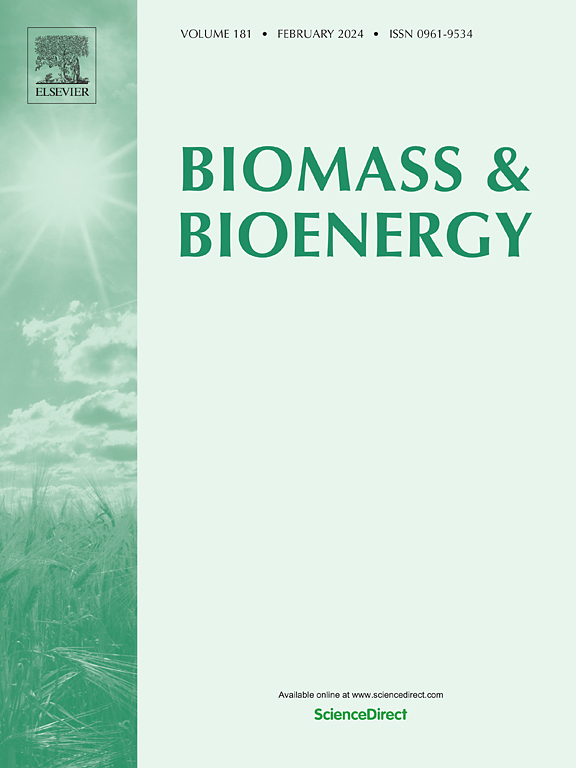Insights into the kinetics of ethyl levulinate production from cellulosic biomass alcoholysis under high solid content
IF 5.8
2区 生物学
Q1 AGRICULTURAL ENGINEERING
引用次数: 0
Abstract
Insight into the alcoholysis kinetics of cellulosic biomass under high solid content to high-value-added ethyl levulinate (EL) is of great significance, but remains challenging due to the co-existence of homogeneous and heterogeneous processes. Herein, the alcoholysis of cellulosic biomass to EL in high solid content systems using CuSO4 as a catalyst was investigated, employing microcrystalline cellulose (MC) as a model compound and xylose residue (XR) as a real cellulosic biomass. Under solid content of 15 %, the yield and concentration of EL from MC reached 29.50 wt% and 35.01 g/L, respectively, and the yield and concentration of EL from XR could reach 22.77 wt% and 27.01 g/L, respectively. A hybrid model consisting of a shrinking-core model and a pseudo-first-order model was established for the first time. The kinetic data analysis revealed that the reaction rate followed the order of 5-ethoxymethylfurfural → EL > glucose → ethyl glucoside > ethyl glucoside → 5-ethoxymethylfurfural > XR → glucose. Meanwhile, there is no significant dependence between the activation energies and the biomass solid content. The activation energies of XR → glucose, a rate-limiting step of the whole alcoholysis, are in the range of 91.30–94.72 kJ/mol under the condition of solid content ranging from 15 % to 25 %. The lower activation energies indicate the potential of XR as a promising raw material for EL preparation.

高固含量纤维素生物质醇解制乙酰丙酸乙酯动力学研究
深入了解纤维素生物质在高固含量条件下向高附加值乙酰丙酸乙酯(EL)的醇解动力学具有重要意义,但由于均相和非均相过程共存,仍然具有挑战性。本文以微晶纤维素(MC)为模型化合物,木糖残渣(XR)为真实纤维素生物质,以CuSO4为催化剂,研究了纤维素生物质在高固含量体系中醇解制EL的过程。在固含量为15%的条件下,MC的EL产率和EL浓度分别达到29.50 wt%和35.01 g/L, XR的EL产率和EL浓度分别达到22.77 wt%和27.01 g/L。首次建立了由缩核模型和伪一阶模型组成的混合模型。动力学数据分析表明,反应速率依次为:5-乙氧基甲基糠醛→EL >;葡萄糖→乙基葡萄糖苷>;乙基葡萄糖苷→5-乙氧基甲基糠醛;XR→葡萄糖。同时,活化能与生物质固含量之间没有显著的相关性。在固含量为15% ~ 25%的条件下,XR→葡萄糖的活化能为91.30 ~ 94.72 kJ/mol。较低的活化能表明了XR作为电致发光原料的潜力。
本文章由计算机程序翻译,如有差异,请以英文原文为准。
求助全文
约1分钟内获得全文
求助全文
来源期刊

Biomass & Bioenergy
工程技术-能源与燃料
CiteScore
11.50
自引率
3.30%
发文量
258
审稿时长
60 days
期刊介绍:
Biomass & Bioenergy is an international journal publishing original research papers and short communications, review articles and case studies on biological resources, chemical and biological processes, and biomass products for new renewable sources of energy and materials.
The scope of the journal extends to the environmental, management and economic aspects of biomass and bioenergy.
Key areas covered by the journal:
• Biomass: sources, energy crop production processes, genetic improvements, composition. Please note that research on these biomass subjects must be linked directly to bioenergy generation.
• Biological Residues: residues/rests from agricultural production, forestry and plantations (palm, sugar etc), processing industries, and municipal sources (MSW). Papers on the use of biomass residues through innovative processes/technological novelty and/or consideration of feedstock/system sustainability (or unsustainability) are welcomed. However waste treatment processes and pollution control or mitigation which are only tangentially related to bioenergy are not in the scope of the journal, as they are more suited to publications in the environmental arena. Papers that describe conventional waste streams (ie well described in existing literature) that do not empirically address ''new'' added value from the process are not suitable for submission to the journal.
• Bioenergy Processes: fermentations, thermochemical conversions, liquid and gaseous fuels, and petrochemical substitutes
• Bioenergy Utilization: direct combustion, gasification, electricity production, chemical processes, and by-product remediation
• Biomass and the Environment: carbon cycle, the net energy efficiency of bioenergy systems, assessment of sustainability, and biodiversity issues.
 求助内容:
求助内容: 应助结果提醒方式:
应助结果提醒方式:


